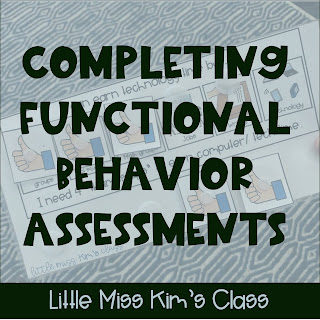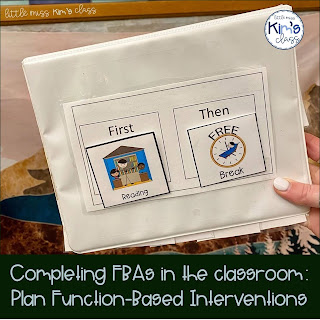- When presented with work during groups, Kim drops her body to the floor and remains on the floor for 60 seconds or more. This does not include when Kim drops her body to the floor and returns to the math table in less than 60 seconds or when she drops to the floor to pick something up.
- Kim won't do her work.
- Kim leaves the work space.
- Kim has tantrums.
- Indirect assessments (family & teacher interviews, rating scales, checklists, etc.)
- Antecedent behavior consequence (ABC) data and other data through direct observations (frequency, duration, latency, etc.)
- Latency data- How long does it take Kim to drop to the floor after she is presented with work? Read more about latency data & download a free data sheet here.
- Duration data- How long does Kim stay on the ground? Read more about duration data & download a free data sheet here.
- ABC data- What happens right before Kim drops to the ground? What happens after Kim drops to the ground? Read more about ABC data & download a free data sheet here.
- Functional Assessment Checklist for Teachers and Staff. Click here to download the free sheet.
- Attention (connection)
- Tangible
- Automatic (sensory)
- Escape (avoidance)
- Kim drops to the floor within 10 seconds of being presented with math work. She does not drop to the floor when presented with reading work or during other lessons/ times of the school day. She also engages in this behavior when presented with math homework at home.
- In school, Kim dropped to the floor when presented with math work 15 out of 15 days data was collected. On average, she stayed on the ground for 27 minutes of the 30 minute math lesson.
- Kim continued to engage in the behavior when the following consequences occurred: verbal re-directions from staff, remarks and attention from peers, when shown visuals, proximity control, loss of privileges.
- According to the data, after a few prompts (verbal and visuals) from staff, the staff members stopped prompting Kim and she remained on the floor.
- All indirect assessments and observation data suggest that the function of Kim's behavior is to avoid/ escape math work. The team's hypothesis is that Kim's dropping to the floor behavior is maintained by getting out of completing math assignments.
- teaching a replacement behavior
- antecedent interventions (preventative strategies)
- consequences: for replacement behavior and target behavior (response strategies)
- taking and analyzing data
- crisis plan, if necessary
- Replacement behavior: Kim will request help and/ or breaks during math by handing a teacher a break card or verbally requesting it.
- Antecedent interventions:
- reducing work demands (i.g. do half of the problems, only do even numbers, complete math centers but not worksheets, etc.)
- scheduling frequent breaks
- offering choice (i.g. what writing utensil to use, what staff member to work with, where to sit, what activity to do first, etc.)
- Consequences (for the replacement behavior and target behavior)
- Replacement behavior (requesting a break or help): Kim requesting a break or help will be positively reinforced by getting a break. The duration and frequency of breaks will be reduced/ faded over time.
- Target behavior (drops to floor): The staff will not remove the math work demand. Kim will be expected to complete some part of the math assignment prior to moving on with the rest of her schedule. Staff can place work (with reduced demand) on floor next to Kim.
- Data: Team will continue to take duration and latency data. Data will be collected daily for 2 weeks. Team will review data on Wednesdays and Fridays. After 2 weeks, team will determine if plan is working.
- Crisis plan: not necessary
Resource Bank
This blog post laid out 6 main steps in the FBA process. I have resources you can download that correspond with several of the sections:
Step 1: Identify and Define the Target Behavior
Resources & more info:
-Defining Problem Student Behaviors (from Intervention Central)
-5 Steps to Meaningful Behavioral Support: Step 1- Focus Assessment by
Defining Behavior (from Autism Classroom
Resources)
Step 2: Collect the Data
Resources & more info:
-Behavior Data Sheets that Will Rock your BIPs (from Autism Classroom Resources)
-Data Sheets (from Behavior Babe)
-Data Collection Resources
-Behavior Documentation Forms (from Earlywood Educational Services)
Step 3: Analyze the Data and Make a Hypothesis
Resources & more info:
-WTF (What's the Function?) (from Adaptation Station)
Step 4: Create a Plan and Stick With It
Resources & more info:
-Handout with Function-Based Interventions (from the Ceedar Center)
-Design a Function-Based Intervention (from the Iris Center)
-Function-Based Strategies (Hieneman)







No comments:
Post a Comment